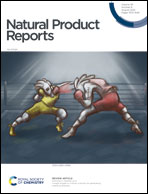Fungal–fungal co-culture: a primer for generating chemical diversity†
Abstract
Covering: 2002 to 2020
In their natural environment, fungi must compete for resources. It has been hypothesized that this competition likely induces the biosynthesis of secondary metabolites for defence. In a quest to discover new chemical diversity from fungal cultures, a growing trend has been to recapitulate this competitive environment in the laboratory, essentially growing fungi in co-culture. This review covers fungal–fungal co-culture studies beginning with the first literature report in 2002. Since then, there has been a growing number of new secondary metabolites reported as a result of fungal co-culture studies. Specifically, this review discusses and provides insights into (1) rationale for pairing fungal strains, (2) ways to grow fungi for co-culture, (3) different approaches to screening fungal co-cultures for chemical diversity, (4) determining the secondary metabolite-producing strain, and (5) final thoughts regarding the fungal–fungal co-culture approach. Our goal is to provide a set of practical strategies for fungal co-culture studies to generate unique chemical diversity that the natural products research community can utilize.

- This article is part of the themed collection: Engineering the biosynthesis of fungal natural products


 Please wait while we load your content...
Please wait while we load your content...